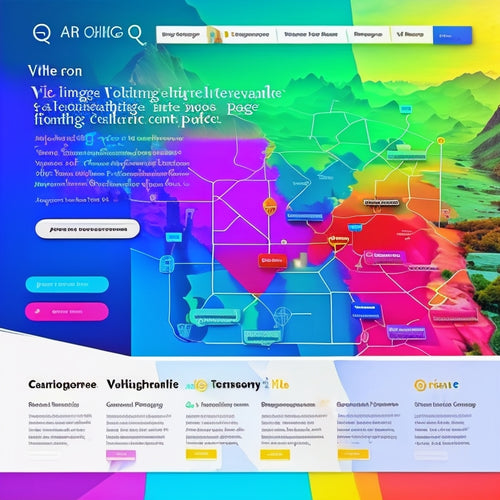
Boost Sales With Digital Product Marketing Strategies
Share
You can boost sales by up to 25% by optimizing your product pages with streamlined layouts, prominent CTAs, and high-quality product images. Leverage social media influencers aligned with your target market to encourage sponsored content creation and product demos. Implement email marketing automation tools to personalize and optimize your messaging. Run targeted paid advertising campaigns using granular targeting options to reach high-intent buyers. By utilizing these digital product marketing strategies, you'll be well on your way to increased sales and revenue. Now, discover the specific tactics and tools that will help you maximize your results.
Key Takeaways
• Optimize product pages with streamlined layouts, prominent CTAs, high-quality images, and customer reviews to increase sales by up to 25%.
• Leverage social media and influencer marketing by partnering with authentic influencers and encouraging sponsored content creation to expand reach and build credibility.
• Utilize email marketing automation and personalization to segment customers, map their journeys, and provide value, resulting in increased loyalty and retention.
• Run targeted paid advertising campaigns using granular targeting options, tailored messaging, and data-driven insights to reach high-intent buyers.
• Enhance the checkout process with secure payment options, multiple payment methods, and personalized suggestions to reduce abandoned carts and boost customer satisfaction.
Optimize Product Pages for Conversion
By tweaking your product pages to prioritize conversion, you can increase sales by up to 25%, as evidenced by a recent study on e-commerce optimization. This is no surprise, given that a well-designed product page is vital to a seamless user experience.
To get it right, you need to focus on the elements that drive conversions. Start by streamlining your page layout, ensuring that your call-to-action (CTA) buttons are prominently displayed and easily accessible.
Next, optimize your product images, using high-quality visuals that showcase your product from different perspectives. Don't forget to include customer reviews and ratings, which can increase trust and credibility.
Finally, use A/B testing to experiment with different page variations, analyzing the data to see what resonates best with your target audience.
Leverage Social Media Influencers Effectively
As you've optimized your product pages for conversion, now it's time to amplify your brand's reach and credibility by partnering with social media influencers who can showcase your products in their own unique way.
Collaborate with influencers who've an authentic voice and a highly engaged audience that aligns with your target market. This partnership can exponentially increase brand awareness, drive website traffic, and boost sales.
To maximize ROI, develop engagement tactics for influencers that encourage them to create sponsored content, product reviews, or demos. Offer incentives such as free products, commission-based sales, or exclusive access to new releases.
Utilize influencer marketing platforms to streamline communication, track performance, and measure campaign success. Analyze engagement metrics, such as likes, comments, and shares, to refine your strategy and optimize future collaborations.
Create Engaging Product Content Strategies
Your product content strategy should be constructed around customer-centric storytelling, utilizing compelling narratives and visuals that connect with your target audience and drive conversions.
To accomplish this, you'll need to develop a deep understanding of your customers' pain points, desires, and motivations. This will allow you to craft stories that speak directly to them, establishing an emotional connection and building trust.
Storytelling techniques such as character development, conflict, and resolution can be utilized to make your content more relatable and engaging. Interactive videos, for example, can be employed to bring your story to life, enabling customers to interact with your product in a more immersive manner.
By integrating interactive elements, you can increase engagement rates by up to 66% and enhance conversions by 25%.
To maximize the impact of your content, concentrate on creating a seamless user experience across all touchpoints. Guarantee that your messaging is consistent, and your visuals are coherent and attention-grabbing.
Utilize Email Marketing Automation Tools
You can greatly enhance the efficiency of your email marketing campaigns by leveraging automation tools that enable you to personalize, optimize, and schedule your communications in advance.
By using customer segmentation, you can create targeted groups based on demographics, behavior, or preferences, and craft personalized messaging that resonates with each segment. Automation tools also allow you to set up behavior-triggered emails, such as welcome emails, abandoned cart reminders, or purchase follow-ups, which can markedly improve engagement and conversion rates.
Effective email marketing automation also involves customer journey mapping, where you visualize and optimize the customer's experience across multiple touchpoints. This helps you identify pain points, opportunities for improvement, and areas where you can provide more value.
With automation tools, you can create a seamless, omnichannel experience that drives customer loyalty and retention. By automating routine tasks, you can focus on high-level strategy and creative direction, freeing up more time to analyze data, refine your approach, and drive revenue growth.
Run Targeted Paid Advertising Campaigns
Paid social media and search engine advertising campaigns that utilize granular targeting options, such as demographics, interests, and behaviors, can help you reach high-intent buyers and drive conversions at a lower cost per acquisition. By using these targeted campaigns, you can guarantee that your message reaches the right people at the right time, increasing the likelihood of a sale.
You can also leverage influencer partnerships to expand your reach and build credibility with your target audience.
When creating social media ads, make sure to tailor your messaging and visuals to resonate with your target audience. Use data-driven insights to optimize your ad creative, bidding, and targeting to maximize ROI.
By leveraging lookalike audiences, custom audiences, and retargeting, you can reach users who are similar to your existing customers or have already shown interest in your product.
Measure and Analyze Performance Metrics
Now that you've launched your digital product marketing campaigns, it's essential to measure their effectiveness.
You'll want to track key performance indicators (KPIs) to gauge success, monitor conversion rates to optimize your funnels, and identify sales bottlenecks to refine your strategies.
Track Key Performance Indicators
By monitoring and analyzing key performance indicators (KPIs), digital product marketers can gain a deeper understanding of their product's performance and make data-driven decisions to optimize its growth. You'll be able to identify areas of improvement, track progress, and adjust your strategies accordingly.
One pivotal KPI to focus on is sales forecasting, which enables you to predict future sales and adjust your marketing strategies to meet demand. Additionally, customer segmentation helps you understand your target audience's needs and preferences, allowing you to tailor your marketing efforts for maximum impact.
Another essential KPI is pricing strategy, which involves analyzing competitors' prices and adjusting your own to stay competitive. This, combined with competitor analysis, helps you stay ahead of the competition and optimize your product's pricing for maximum revenue.
Monitor Conversion Rates
You can greatly enhance your digital product's revenue by monitoring conversion rates, which provide a clear picture of how effectively your marketing strategies are driving desired actions, such as form submissions, sign-ups, or purchases. By tracking conversion rates, you can identify areas of improvement and optimize your marketing efforts to maximize ROI.
Here are some key aspects to focus on when monitoring conversion rates:
-
Set clear goals: Define specific conversion goals, such as increasing sign-ups or purchases, to guide your analysis.
-
Track multiple metrics: Monitor conversion rates across different channels, such as social media, email, and paid ads, to identify top performers.
-
Analyze data regularly: Regularly review conversion rate data to identify trends and patterns.
-
Compare to benchmarks: Compare your conversion rates to industry benchmarks to gauge performance.
-
Use data to improve strategies: Analyze data to identify areas for improvement and adjust marketing strategies accordingly.
Identify Sales Bottlenecks
To optimize your digital product's sales funnel, start by pinpointing the specific stages where customers are dropping off, as this will allow you to identify and address the most critical sales bottlenecks. By analyzing your website analytics, you'll uncover areas where customers are losing interest or encountering friction. This data will help you identify customer personas and their pain points, enabling you to tailor your marketing strategies to their needs.
Next, assess your customer journey to determine where they're falling off. Is it during the checkout process, or when they're exploring product features? Once you've pinpointed these bottlenecks, you can develop targeted solutions to improve the customer journey. For instance, you might streamline your checkout process, offer personalized product recommendations, or provide clear and concise product information.
Frequently Asked Questions
How Do I Handle Negative Product Reviews and Customer Feedback Online?
When handling negative reviews, you'll protect your brand image by responding promptly, addressing concerns, and showcasing customer satisfaction through reputation management and online engagement, ensuring a positive digital footprint that drives loyalty and sales.
Can I Really Make Money Selling Digital Products With Low Prices?
You can definitely profit from low-priced digital products by optimizing pricing strategies for customer acquisition, conducting thorough market research, and outsmarting competitors through data-driven competitive analysis.
What's the Best Way to Protect My Digital Product From Piracy?
"Can you really afford to lose sleep over digital thieves? Protect your product with robust copyright protection, encryption, and anti-piracy measures like watermarks - it's a digital armor you can't afford to neglect."
How Often Should I Update My Digital Product to Stay Competitive?
You should update your digital product every 3-6 months, driven by product development cycles and competitive analysis, while fostering customer engagement through market research to stay ahead of the curve.
Can Digital Product Marketing Strategies Work for B2B Businesses Too?
"In the era of steam-powered innovation, you're wondering if digital product marketing strategies can fuel your B2B engine. Absolutely, they can! By leveraging B2B partnerships, marketing automation, and account-based advertising, you'll generate quality leads and drive revenue like a well-oiled machine."
Related Posts
-

Social Proof Shopify Apps Help Build Trust Among Customers by Displaying Real Reviews and Actions
This article explores the benefits of using social proof Shopify apps to build trust among customers. By displaying ...
-

The SEO Benefits of Sitemaps for Improved Website Visibility
This article explores the SEO benefits of sitemaps for enhancing website visibility. Sitemaps serve as navigational ...
-

How Do I Add a Pop-Up Sale on Shopify
This article discusses the process of adding a pop-up sale on the Shopify platform. It aims to provide an informativ...


